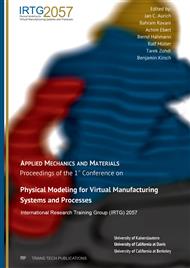[1]
A. Pellegrino, Assessment of Artificial Lighting Parameters in a Visual Comfort Perspective, Lighting Research and Technology, vol. 31, no. 3, p.107–115, (1999).
DOI: 10.1177/096032719903100305
Google Scholar
[2]
C. Chou, C. -C. Lu, and R. Huang, Effects of different ambient environments on human responses and work performance, Journal of Ambient Intelligence and Humanized Computing, vol. 7, no. 6, p.1–10, (2016).
DOI: 10.1007/s12652-016-0393-0
Google Scholar
[3]
K. Papamichael, M. Siminovitch, J. A. Veitch, and L. Whitehead, High Color Rendering Can Enable Better Vision without Requiring More Power, LEUKOS - Journal of Illuminating Engineering Society of North America, vol. 12, no. 1–2, p.27–38, (2016).
DOI: 10.1080/15502724.2015.1004412
Google Scholar
[4]
Comité Européen De Normalisation, Light and Lighting - Lighting of Workplaces — Part 1: Indoor Work Places. EN 12464-1, (2011).
Google Scholar
[5]
Standards Australia, Interior and Workplace Lighting — Part 1: General Principles and Recommendations. AS/NZS 1680. 1: 2006, (2006).
Google Scholar
[6]
International Organization for Standardization, Lighting of work places — Part 1: Indoor. ISO 8995-1: 2002, (2002).
Google Scholar
[7]
T. Hong, S. . Chou, and T. . Bong, Building simulation: an overview of developments and information sources, Building and Environment, vol. 35, no. 4, p.347–361, May (2000).
DOI: 10.1016/s0360-1323(99)00023-2
Google Scholar
[8]
D. E. Christakou and C. N. D. Amorim, Daylight Simulation: Comparison of Softwares for Architect's Utilization, in IBPSA Proceedings: Building Simulation Conference, 2005, p.183–190.
Google Scholar
[9]
C. F. Reinhart and S. Herkel, The Simulation of Annual Daylight Illuminance Distributions- A State-of-the-Art Comparison of Six RADIANCE-based Methods, Energy and Buildings, vol. 32, no. 2, p.167–187, (2000).
DOI: 10.1016/s0378-7788(00)00042-6
Google Scholar
[10]
S. Attia, L. Beltran, A. de Herde, and J. L. M. Hensen, 'Architect Friendly': a comparison of ten different building performance simulation tools, in IBPSA Proceedings: Building Simulation Conference, 2009, p.204–211.
Google Scholar
[11]
G. G. Roy, A Comparative Study of Lighting Simulation Packages Suitable for use in Architectural Design, (2000).
Google Scholar
[12]
J. Ashmore and P. Richens, Computer Simulation in Daylight Design: a comparison., Architectural Science Review, vol. 44, no. 1, p.33–44, (2001).
DOI: 10.1080/00038628.2001.9697451
Google Scholar
[13]
C. E. Ochoa, M. B. C. Aries, and J. L. M. Hensen, State of the art in lighting simulation for building science: a literature review, Journal of Building Performance Simulation, vol. 5, no. 4, p.209–233, (2012).
DOI: 10.1080/19401493.2011.558211
Google Scholar
[14]
A. Iversen, N. Roy, M. Hvass, M. Jørgensen, J. Christoffersen, W. Osterhaus, and K. Johnsen, Daylight Calculations in Practice: An Investigation of the Ability of Nine Daylight Simulation Programs to Calculate the Daylight Factor in Five Typical Rooms, 1st Editio. SBI, (2013).
Google Scholar
[15]
S. H. Shikder, A. D. F. Price, and M. Mourshed, Evaluation of four artificial lighting simulation tools with virtual building reference, in Proceedings of the European Simulation and Modelling Conference (ESM), 2009, p.77–82.
Google Scholar
[16]
M. S. Ubbelohde and C. Humann, Comparative Evaluation of Four Daylighting Software Programs, ACEE Summer Study on Energy Efficiency in Buildings, vol. 1988, p.16, (1998).
Google Scholar
[17]
P. L. and C. J. A., Communicating Building Simulation Outputs to Users, in Proceedings of the Eighth International IBPSA Conference, August 11-14, 2005, Eindhoven, Netherlands, (2003).
Google Scholar
[18]
S. Srivastav, S. Lannon, D. K. Alexander, and P. Jones, A Review and Comparison of Data Visualization Techniques Used in Building Design and in Building Simulation, in IBPSA Proceedings: Building Simulation Conference, 2009, p.1942–(1949).
Google Scholar
[19]
K. Haeb, S. Schweitzer, D. Fernandez Prieto, E. Hagen, D. Engel, M. Bottinger, and I. Scheler, Visualization of Building Performance Simulation Results: State-of-the-Art and Future Directions, 2014 IEEE Pacific Visualization Symposium, p.311–315, Mar. (2014).
DOI: 10.1109/pacificvis.2014.34
Google Scholar
[20]
National Framework for Energy Efficiency - Australia, Training Guide: The Basics of Efficient Lighting., (2009).
Google Scholar
[21]
Zumtobel Lighting GmbH, The Lighting Handbook, 4th Edition. Dornbirn, Austria, (2013).
Google Scholar
[22]
B. Shneiderman, The Eyes Have It: A Task by Data Type Taxonomy for Information Visualizations, in Proceedings 1996 IEEE Symposium on Visual Languages, 1996, p.336–343.
DOI: 10.1109/vl.1996.545307
Google Scholar
[23]
J. Yi, Y. A. Kang, and J. Stasko, Toward a Deeper Understanding of the Role of Interaction in Information Visualization, IEEE Transactions on Visualization and Computer Graphics, vol. 13, no. 6, p.1224–31, (2007).
DOI: 10.1109/tvcg.2007.70515
Google Scholar
[24]
A. Kerren and F. Schreiber, Toward the Role of Interaction in Visual Analytics, in Proceedings of the Winter Simulation Conference, 2012, p.420.
DOI: 10.1109/wsc.2012.6465208
Google Scholar
[25]
J. C. Roberts, State of the Art: Coordinated Multiple Views in Exploratory Visualization, " in CMV , 07 Proceedings of the Fifth International Conference on Coordinated and Multiple Views in Exploratory Visualization, 2007, p.61–71.
DOI: 10.1109/cmv.2007.20
Google Scholar
[26]
C. Ahlberg, C. Williamson, and B. Shneiderman, Dynamic Queries for Information Exploration: An Implementation and Evaluation, " in Proceedings of the SIGCHI conference on Human factors in computing systems - CHI , 92, 1992, p.619–626.
DOI: 10.1145/142750.143054
Google Scholar
[27]
H. Doleisch, M. Gasser, and H. Hauser, Interactive feature specification for focus+ context visualization of complex simulation data, " VISSYM , 03 Proceedings of the Symposium on Data Visualisation, p.239–249, (2003).
Google Scholar
[28]
R. C. Gonzalez and R. E. Woods, Digital Image Processing, 3rd Editio. Pearson Prentice Hall, (2008).
Google Scholar
[29]
J. Kehrer and H. Hauser, Visualization and Visual Analysis of Multifaceted Scientific Data: A Survey, IEEE Transactions on Visualization and Computer Graphics, vol. 19, no. 3, p.495–513, (2013).
DOI: 10.1109/tvcg.2012.110
Google Scholar
[30]
J. Schmidt, M. E. Groller, and S. Bruckner, VAICo: Visual analysis for image comparison, IEEE Transactions on Visualization and Computer Graphics, vol. 19, no. 12, p.2090–2099, (2013).
DOI: 10.1109/tvcg.2013.213
Google Scholar
[31]
H. -G. Pagendarm and F. H. Post, Comparative Visualization: Approaches and Examples, Visualization in Scientific Computing, p.95–108, (1995).
Google Scholar
[32]
T. Nocke, M. Flechsig, and U. Bohm, Visual exploration and evaluation of climate-related simulation data, in Simulation Conference, 2007 Winter, 2007, p.703–711.
DOI: 10.1109/wsc.2007.4419664
Google Scholar


